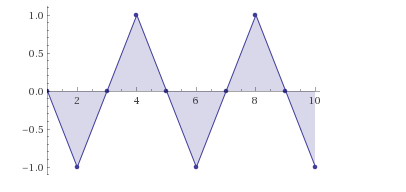Using the first 10 terms graph the sequence, and use the graph to discuss the convergence or divergence of the sequence an=cos(npi/2)?
1 Answer
Diverges due to oscillation of the cosine.
Explanation:
Determine the first
It's worth noting here that we've completed one period of the cosine function. From here on, it'll be obvious that the values repeat.
We must then plot the following points:
Don't connect them, although this graphing program might. Sequences aren't continuous, they only exist at integers. This program has done connecting and shading for visualization purposes only.

A sequence
In the above plot, we do not approach positive or negative infinity, but we do not quite approach a finite value either. The sequence is perpetually oscillating between

